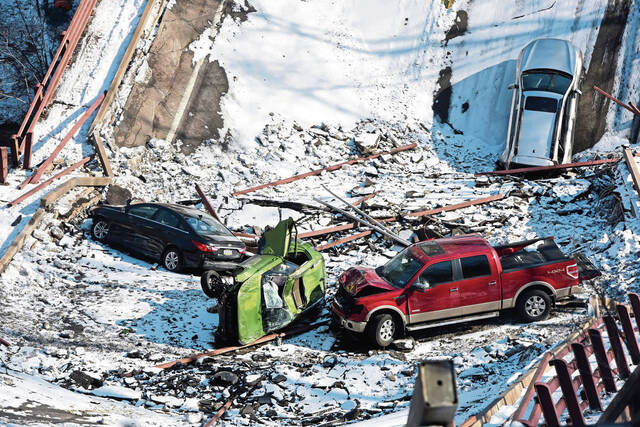Victims of the Fern Hollow Bridge collapse are fighting for records that might shed more light on what the City of Pittsburgh knew about the crumbling span before disaster struck.
But in the face of potential liability, the city is vigorously trying to block those efforts in court, claiming that state and federal law shield the records from being used in lawsuits.
Even as investigators with the National Transportation Safety Board reach the late stages of their probe into the collapse, the city and the victims continue to battle over critical information about the condition of a key roadway that once carried thousands of motorists a day and whose failure spurred a citywide review of its hundreds of bridges.
This week, lawyers for Daryl Luciani, a Pittsburgh Regional Transit driver from West Newton whose 60-foot-long bus tumbled into a deep ravine in Frick Park when the bridge gave way, filed their latest court papers as part of a continuing effort to pry the records loose.
They argue that the specific information they seek is not covered under the laws cited by the city and should be turned over.
As part of their strategy to wrest the records free, they’re seeking to subpoena not the city but third-party engineering firms believed to have been contracted for work on the Fern Hollow Bridge.
Left to sort out these dueling positions is Allegheny County Common Pleas Judge Philip A. Ignelzi, who is overseeing the complex litigation involving the collapse. He has scheduled a hearing for Nov. 16.
So far, two couples have sued the city alleging negligence: Velva and Tyrone Perry, and Thomas and Sara Bench. The Perrys and Thomas Bench were caught in the collapse.
Other victims, including Luciani, have filed notice of their intent to sue. They are Matthew Evans, a bus passenger; motorist Joseph Engelmeier; and Clinton Runco, a dentist whose car shot into the void either as the bridge fell or after it went down, and his wife, Irene.
On Jan. 28, 2022, the city-owned bridge abruptly gave way in the pre-dawn darkness, hurtling a bus and several vehicles into the snow-covered ravine. The incident happened just a few hours before the scheduled arrival of President Biden in Pittsburgh to tout a trillion-dollar infrastructure bill. The timing immediately drew a national spotlight to one of the worst infrastructure catastrophes in the city’s history.
The span’s sudden failure caused long-lasting injuries and psychological trauma for its victims, disrupted traffic in the city’s East End for months and focused attention on the dire state of bridges throughout Pennsylvania.
For years, inspectors had noted deteriorating conditions along the 447-foot bridge, part of Forbes Avenue, that stretched over the gorge in Frick Park. But the full account of what they and the various private contractors told the city has been shrouded in mystery.
The city never conducted a major overhaul despite the span’s structurally deficient rating, opting instead for patchwork fixes, like installing a cross bracing for the rust-pocked legs.
Why a comprehensive repair didn’t occur, what the city knew about the bridge’s weaknesses, who made the decisions, and who is to blame – those are all questions that the plaintiffs’ lawyers have.
Now, attorneys for Luciani and other victims swept up in the calamity are trying to subpoena 15 years worth of bridge records from private engineering firms in Pittsburgh that they hope will provide answers.
Among the records that lawyers Peter Giglione and Steven Barth want from CDM Smith, Gannett Fleming and Michael Baker International: bridge problem reports, critical finding letters, load and structural analyses, inspection reports, and correspondence with the city.
The bridge reopened to traffic in December.
Attorneys for Pittsburgh are refusing to allow the subpoenas to proceed without a fight. They contend that a 1987 federal law forbids use of this kind of material in lawsuits and that the subpoenas should be denied.
Congress passed the protections in the wake of a 1970s-era federal program that doled out funds to find and fix the nation’s most dangerous roads, according to an article published by the Transportation Research Board, part of the National Academies of Sciences, Engineering, and Medicine.
“After the Hazard Elimination Program was introduced, states and local governments loudly voiced concerns that their liability risks would increase when the law was implemented,” the article said.
Governments feared that if trouble spots were pinpointed but not immediately addressed, they could be sued for millions of dollars by accident victims alleging that agencies were aware of problems but didn’t fix them. So they lobbied Congress for help.
Those concerns never abated. In 2012, another federal transportation law meant to reduce traffic deaths called on states to identify trouble spots in their highway systems, compile reams of data — accident reports, engineering studies, field studies — and come up with improvements.
“If this data were made available to the general public and the legal community,” according to the paper, “it could spawn millions of dollars in litigation costs for the agencies.”
City of Pittsburgh lawyers are acutely aware of the federal law. They referenced it in both their objections to the subpoenas sought by Luciani’s lawyers and the lawsuit filed by the Perrys.
The federal law explicitly prohibits certain records “compiled or collected” in connection with specific highway safety programs to be admitted as evidence in court or for suing for damages.
The city’s attorneys also cited part of Pennsylvania’s vehicle code, which exempts from trials “in-depth accident investigations and safety studies and information, records and reports used in their preparation.”
Pennsylvania law applies, city attorneys said, because the state Department of Transportation selects bridge inspectors who work under state and federal standards.
Luciani’s lawyers dismissed the city’s arguments. They claimed that the laws don’t specifically address the particular records they seek.
And they argued that since they’re asking private third parties for the records, not government entities such as PennDOT, the laws don’t apply.
The city’s posture is unsurprising.
Earlier this year, Pittsburgh’s Law Department fought against turning over inspection reports, maintenance and payment records, citing a prohibition by the safety board. Pittsburgh also sought a gag order in the case, which was denied.
Wylie Aitken, a trial lawyer in Southern California, has squared off against opponents who invoked the federal protections. He believes the law should be amended.
“It’s good intentions gone bad,” said Aitken, a former head of the California Trial Lawyers Association. “Here we’re talking about blocking relevant information that a jury or a judge should hear in order to determine whether these individuals were victimized and entitled to fair compensation for what they suffered and what could have been avoided.”
Aitken has dealt with attempts to shield information under the law several times, including a case in which a teenage girl was severely injured when she was struck by a car in a crosswalk at a high school. Barring the information from court can hinder plaintiffs’ lawyers from effective cross-examination, he said.
“They knew about the condition, they knew about it for a long time, they studied it ad nauseam without taking any action,” Aitken said.
In the Perrys’ complaint, lawyers C.J. Engel and Paul Ellis cite information from bridge inspection reports dating to 1997 that documented steady problems with water leakage, corrosion of the bridge’s legs and deterioration of the cross bracing between the bridge legs.
The Fern Hollow Bridge opened to traffic in 1973. Starting in 2011, inspectors rated it in poor condition.
As the years passed, according to inspection entries cited in the lawsuit, the language and warnings continued, and the problems seemed to accelerate, but never enough to warrant a shutdown or major renovation.
Each of the bridge reports went to Pittsburgh officials, the lawsuit said, “meaning that for at least 25 years, the City was aware of the need to address and repair drainage problems on the bridge as well as the advanced and progressive deterioration of the bridge legs and cross bracing between the bridge legs.”
The Perrys claim that the city did not properly maintain the span and failed to replace or repair its severely corroded legs “to ensure the structural support of the bridge.”
The bridge legs have been a focus of the federal investigation, which is close to wrapping up.
A safety board spokeswoman said Wednesday that the agency expects to finish its final report on the bridge collapse in the first quarter of 2024. That report — which is not admissible in court — should include the probable cause of the failure.
In May, the safety board issued an interim report that underscored the damage that years of clogged drains and corrosion wreaked on the Fern Hollow Bridge. Investigators also called out the lack of maintenance in response to inspection reports that flagged the problems.
That same report also urged bridge owners to address a critical issue: water and debris building up in the 10,000 spans across the country built from uncoated weathering steel, the same material as the Fern Hollow Bridge.
Jonathan D. Silver is a Tribune-Review staff writer. You can contact Jonathan at jsilver@triblive.com.





